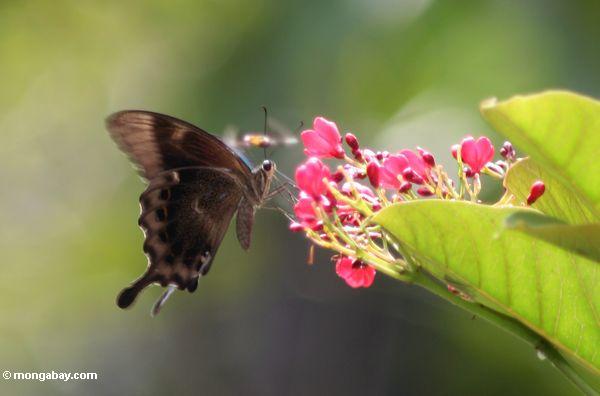Speaking at the American Museum of Natural History in New York City, UN Secretary General Ban Ki-moon said that “business as usual is not an option” to protect the world’ s biodiversity. The failure of governments worldwide to meet their pledges to protect biodiversity by 2010 is “a wake up call” according to Ki-moon.
Ki-moon told over 400 attendees, including scientists, UN experts, and development experts that “we need a new biodiversity vision […] We must ensure the long-term viability of our seas and oceans […] We must manage our forest sustainability […] We must preserve coral reefs so they can continue to protect coasts from storms and support livelihoods.”
The director of the Center for Biodiversity and Conservation at the museum, Eleanor Sterling remarked that “we’ve lost sight of the biodiversity crisis because of other global challenges like climate change. But now we need to step back, understand the causes and consequences of our continued impact on life on the planet, and develop realistic and comprehensive strategies that allow dynamic human communities, economies, and life to thrive.”
Increasingly scientists and policymakers have underlined the link of biodiversity preservation to the economy. A rich biodiversity provides a number of environmental services, such as pollination, food security, pest control, freshwater, medical breakthroughs, and carbon sequestration.
In 2002 nations pledged that by this year they would achieve a ‘significant reduction’ in biodiversity loss. They have failed: if anything the extinction crisis today is worse than it was eight years ago.
Extinctions are estimated to be occurring at 1,000 times the natural background rate, and many ecologists believe we are entering a period of global mass extinction similar to the one that wiped out the dinosaurs—only this time the cause is not otherworldly, like a comet, but due to human impacts.
The gathering was hosted by Conservation International, Fordham University, United Nations Development Programme (UNDP), United Nations Foundation, and the Wildlife Conservation Society.
Butterfly feeding on pink flower in Bali, Indonesia. Photo by: Rhett Butler.
Related articles
Half of Indonesia’s species remain unknown
(02/02/2010) Incorporating 17,000 tropical islands, Indonesia is one of the world’s richest areas of biodiversity. However, according to the Jakarta Post, over half of this biodiversity remains unrecorded with only 20 of the more than 400 regencies in the country recording species.
Why top predators matter: an in-depth look at new research
(02/02/2010) Few species have faced such vitriolic hatred from humans as the world’s top predators. Considered by many as pests—often as dangerous—they have been gunned down, poisoned, speared, ‘finned’, and decimated across their habitats. Even where large areas of habitat are protected, the one thing that is often missing are top predators. However, new research over the past few decades is showing just how vital these predators are to ecosystems. Biologists have long known that predators control populations of prey animals, but new studies show that they may do much more. From controlling smaller predators to protecting river banks from erosion to providing nutrient hotspots, it appears that top predators are indispensible to a working ecosystem. Top predators sit at the apex of an ecosystem’s food chain. Wolves in Alaska, tigers in Siberia, lions in Kenya, white sharks in the Pacific are all examples of top predators.
Loss in biodiversity may be killing bees
(01/20/2010) A decline in diverse plants species on which to feed may be causing a similar decline in bee survival, according to a new paper in Biology Letters.
Photos: park in Ecuador likely contains world’s highest biodiversity, but threatened by oil

(01/19/2010) In the midst of a seesaw political battle to save Yasuni National Park from oil developers, scientists have announced that this park in Ecuador houses more species than anywhere else in South America—and maybe the world. “Yasuní is at the center of a small zone where South America’s amphibians, birds, mammals, and vascular plants all reach maximum diversity,” Dr. Clinton Jenkins of the University of Maryland said in a press release. “We dubbed this area the ‘quadruple richness center.'”
Saving biodiversity ‘on the same scale’ as climate change: German Chancellor
(01/11/2010) In a kick-off event for the UN’s Year of Biodiversity, German Chancellor Angela Merkel, compared the importance of saving biodiversity to stopping climate change.
Gone: a look at extinction over the past decade

(01/03/2010) No one can say with any certainty how many species went extinct from 2000-2009. Because no one knows if the world’s species number 3 million or 30 million, it is impossible to guess how many known species—let alone unknown—may have vanished recently. Species in tropical forests and the world’s oceans are notoriously under-surveyed leaving gaping holes where species can vanish taking all of their secrets—even knowledge of their existence—with them.
Pope Benedict: environmental crisis requires review of world’s economic model
(12/15/2009) Pope Benedict XVI has released a message linking world peace with preserving the environment for the World Day of Peace, which will be held on January 1st 2010. In it Benedict calls for a “long-term review” of the world’s current economic model, including “[moving] beyond a purely consumerist mentality” and encouraging a more “sober lifestyle”.
Zoos call for deeper emission cuts to save life on Earth
(11/30/2009) To save species around the world zoos say deeper emission cuts are needed than governments are currently proposing. Over 200 zoos worldwide have signed a petition calling on governments to set the target of atmospheric carbon below 350 parts per million (ppm) far lower than most government targets.

